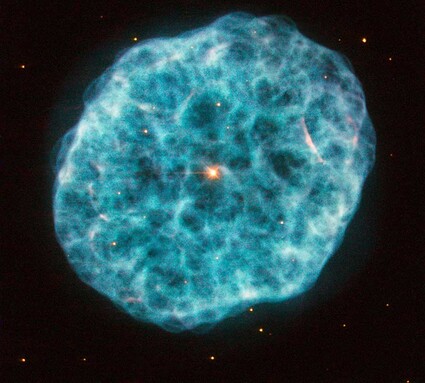Stars over Sisters 1/04/2023
Last updated 1/3/2023 at Noon

COURTESY HST/NASA
The Oyster Nebula is a planetary nebula located 4,240 light-years away in the constellation of Camelopardalis.
The highlighted constellation for January is Camelopardalis, the celestial giraffe. Although the constellation is relatively large, its resident stars are exceedingly faint.
Choose a clear, moonless night away from the glare of nearby lights. First locate Polaris (the North Star) at the end of the handle of the Little Dipper. Next find the bright star Capella in Auriga, which is nearly overhead at about 9 p.m. local time. Starting from Capella, draw an imaginary line to Polaris. About a third of the distance along this line is the constellation’s brightest star, Beta Camelopardalis. The third brightest luminary is Alpha Camelopardalis, which lies about halfway between Capella and Polaris. It marks the base of the giraffe’s neck and the top of the front leg.
Because stargazers in ancient Greece believed the part of the sky where Camelopardalis resides was empty, there is no associated mythology. The constellation wasn’t even established until 1613, when Dutch-Flemish astronomer Petrus Plancius created it. Camelopardalis became recognized in 1624, when Jakob Bartsch, a German astronomer from Poland, featured it in his star atlas.
While there is a long list of deep-sky objects in Camelopardalis, the vast majority of them are dim galaxies. A notable exception is the Oyster Nebula, a planetary nebula located between the giraffe’s legs. The expanding shell of gas and dust was created by a hot, rapidly pulsating central star in the late stage of its life. Appearing as a bright orange dot at the center of the glowing cloud, the star looks like a pearl in a large celestial oyster, giving the object its name. It lies at a distance of 4,240 light-years.
Perhaps the most interesting galaxy in Camelopardalis is IC342. It is a beautiful face-on spiral galaxy that is currently undergoing a strong burst of star formation. Despite being a respectable three-quarters the size of our own Milky Way galaxy, and lying only 10 million light-years away, IC342 doesn’t appear as bright as it should. The reason for this is that obscuring dust in the Milky Way is blocking/scattering light from this galaxy. Were it not for this dimming effect, IC342 would be one of the finest and brightest spiral galaxies in the sky and easily visible to the unaided eye from a dark location.
Four of the five naked-eye planets still roam the evening skies. The brightest of these are Jupiter, currently in Pisces (look to the southwest), and ruddy Mars riding high in Taurus. Venus is also bright, but at the beginning of the month it stands only 9 degrees above the horizon 20 minutes after sunset. Though Saturn is still visible, the sun continues to creep ever closer to the ringed planet. On January 22 Venus and Saturn will be in conjunction, at which time the two planets will appear separated by less than half a degree in the sky.
Uranus in Aries and Neptune in Aquarius are evening objects too but can’t be seen without optical aid. Meanwhile, Mercury has pulled a disappearing act. It will materialize in the morning sky later in the month.
As the moon cycles through its phases in January, the waxing orb brightens evening skies both early and late in the month; darker skies will prevail by the middle of the month. The Full Wolf Moon arrives on January 6, followed by last quarter on January 14, new moon on January 21, and first quarter on January 28.
Although for most of us the holiday season ends after New Year’s Day, many will continue to display their decorative lights well into January. This month’s dark-sky tip is to use timers on these lights. This adaptive control measure saves energy and avoids unnecessary light pollution. Simply set outdoor lights to turn off before you go to bed.











Reader Comments(0)